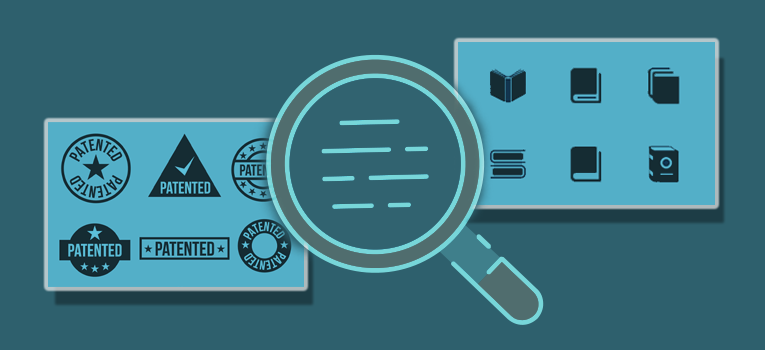Patentability Search is also referred to as the Prior Art Search or Novelty Search. In other words, a patentability search explores any reference of any type that can disclose the same or similar invention to the one in question. It aims to discover if the features of the current invention coincide with any of the existing ones. Any invention can only be patented if it is novel; therefore, this search enables the patentability searcher to find any relevant references that existed before the invention’s critical date.
The obviousness of an invention is non-quantifiable, just like the concept of similarity is subjective. Therefore, patentability searches are often conducted after breaking it into four primary relevancy criteria:
- Non-relevancy
- Distinctive Relatedness
- Relatedness
- Relevancy
Both patent and non-patent literature are scrutinized intensively by experts to uncover relevant and related references that can be regarded as sources of prior art for the invention in question.
A patentability search is performed at the earliest possible during the invention’s development stage. However, it can generally be completed before submitting the patent application to check its patentability.
Why Conduct a Patentability Search
Patentability or prior art search is performed to ascertain the chances or likelihood of an invention being patented, based on the globally recognized criteria of novelty and non-obviousness.
A patentability search should be performed before the process of filing a patent begins. Inventions take a lot of effort and expense, so, before filing, the inventor has to make sure that nobody else staked a claim for the concerned invention.
It is necessary to perform a patentability search for several reasons:
-
A patentability search gives the inventor a better understanding of the invention’s scope.
-
It helps the patent drafter draft the claims appropriately by providing a better understanding of the invention over the existing prior art.
-
The applicant has to be more prepared when it comes to providing justifications for rejections—this may or may not arise throughout the examination phase.
-
It is not legally required for an inventor to carry out a patentability search; however, a patentability search is one of the initial steps an inventor takes when he embarks on the patent process. Ensuring that the innovation is novel is practical to consider before commencing production to ensure that the invention is novel and patentable.
Pros of Conducting a Patentability Search
There are several convincing reasons to get a patentability search done. Two of these are:
-
Patentability search provides an insight into the scope of patent protection granted to the United States Patent and Trademark Office (“USPTO”). These search results help formulate decisions about how one decides to invest additional time and funds into developing the concerned innovation—for example, costs, equipment purchase, legal charges, etc.
-
The other advantage is that the search results help the patent attorney draft the patent application claims. For example, suppose the searcher discovers prior art similar to your invention. In that case, the patent attorney drafts the patent application to point out the differences in your innovation from the prior art. This feat dramatically enhances the chances of acceptance of patent protection.
Cons of Patentability Search:
Even after several needed reasons to get this search done, the accuracy of a patentability search is minimal for several reasons:
-
The scope of the investigation can be very narrow and limited at times. This leads to missing out on several crucial prior art resources.
-
In some cases, the existing patents might be poorly translated, misclassified, or may even be un-retrievable due to some errors or omissions in the data available from various patent offices.
-
Another reason for the patentability search’s inaccuracy is that one can never search for something unavailable to be searched. For example, pending patent applications cannot be found in many patent offices. In other cases, after a certain period has elapsed (around 18 months), finding such applications is not possible. Depending on the country and circumstances, a previously filed patent application can effectively block a filed patent application.
-
A patentability search does not provide any information on whether your product would infringe on other patents or not. Just because one has a patentable innovation does not give it the right to be free from infringement risks, it is possible to get your invention patented and still have a patented product infringing on other patents. This helps to understand the difference between patentable and infringing patent applications.
Generalized Steps While Performing a Patentability Search:
One can perform a patentability search using free software or ask a law firm to do the same after payment of some fee. There are several other affordable options, such as patent search by Patentcloud, that innovators can use while getting it done. One has to make a mindful choice regarding free patent search databases and free websites.
To perform your patentability search by themselves, these generalized steps are to be performed:
-
Choosing a suitable keyword for the invention.
-
Putting it into a patent search tool.
-
Start a broadened search followed by a narrow one to ensure that nothing is missed.
-
Select the most suitable CPC classification to search for appropriate patent documents with the most similar to the invention.
-
Scrutinize all kinds of resources, including, PatFT (issued patents) and AppFT (published patent applications) documents that have the closest matching CPC classification that one can find.
-
Use citations of the most relevant patents’ prior art from your search to find more related patent documents.
-
Broaden the search domain by repeating this entire process (TABULATE).
Some of the databases used for patentability search purposes are Google Patents, USPTO search interface, Espacenet (European Patent Office) search interface, WIPO search interface, Patent Lens, etc.



